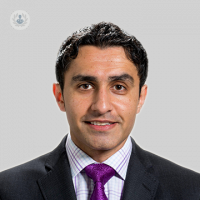5 common ENT problems in children
Escrito por:Children are constantly on the go, so it should come as no surprise they’re quick to pick up infections. Ear, nose and throat (ENT) conditions are common in children, meaning you’re pretty likely to be visiting your GP every once in a while if you have a little one. Expert otolaryngologist (ear, nose and throat doctor) Mr Ravinder Natt explains some of the most common ENT conditions children come down with, and how you might be able to spot symptoms of them.

1. Glue ear
Glue ear is a very common condition found in children, in which the middle ear gets filled with fluid, rather than air. This can lead to hearing loss, either in one or both ears, which can sound rather like what you hear when you cover your ears with your hands. Glue ear usually heals by itself and the fluid drains, but if your child has symptoms of glue ear which have lasted over three months, treatment may be necessary, usually in the form of a minor surgical procedure. If your child struggles to keep up with a conversation, becomes irritated or tired as a result of having to try harder to hear you, or turns up the volume on the TV set, these might be signs of glue ear.
2. Sleep apnoea
Children can often stop breathing at night, and it’s nothing to worry about – we all experience this, children or adults. Apnoeas are temporary pauses of breathing during sleep. Sleep apnoea is actually more common in adults, but the causes are different. In adults, sleep apnoea is connected to weight and age, but in children, sleep apnoea is usually caused by a relaxation in the throat while sleeping, allowing the tonsils or adenoids to obstruct it. Children who have sleep apnoea may snore, breathe through their mouth and experience pauses in breath while sleeping, feel tired or sleepy during the day, have problems concentrating at school, and some display behavioural issues.
Because in children the commonest cause of sleep apnoea is enlarged tonsils or adenoids, many cases are treated through surgical removal of the tonsil/adenoid tissue. In other cases, medication, lifestyle changes, or perhaps oral appliances may be used, depending on the cause of the apnoea.
3. Tonsillitis
Both adults and children can get tonsillitis, and it can often feel like a bad cold or flu for the sufferer. Tonsillitis is usually caused by a viral infection but can be bacterial, and it can display various symptoms including headache, cough, earache, problems swallowing, hoarseness, a fever or high temperature, and feeling nauseous. A general sense of fatigue – feeling tired – is also common.
In young children you can manage symptoms by using the right dose of painkillers, cool drinks, and perhaps sprays or solutions to help manage a sore throat.
Tonsillitis may recur in children, and if the infection frequently returns, your doctor or a specialist can advise on the best course of treatment which will often require a daycase tonsillectomy procedure to improve quality of life.
4. Rhinitis
Rhinitis is a common condition in which the lining of the nose becomes inflamed. This causes a blocked and/or runny nose, mucus dripping or accumulating in the throat (post-nasal drip), difficulties with smell, and in children, a persistent cough. In many cases rhinitis is caused by an allergic reaction, but your healthcare provider will check to see if this is the case. Treatment of rhinitis varies and it is best to consult a doctor or specialist who can tailor treatment to your child and their needs.
5. Ear infections
Five out of six children will have had an ear infection by the time they are three - ear infections are one of the most common reasons parents take their child to visit the GP. Ear infections are usually caused by bacteria, and they often happen after your child has had a cold, a sore throat, or other type of infection. Ear infections often happen in very young children who have not yet learned to talk, so it can be useful to know the signs of one:
- Pulling or tugging their ears
- Balance problems
- Not responding to speech, or quiet sounds
- Excessive crying
- Fever
- Fluid coming from the ear
- Clumsy behaviour
While these conditions are common, and easily treatable, if they happen over a long period of time, or come back time and time again, your child may be referred for specialist treatment. You can also help to prevent against infections in the home, by washing your hands frequently, not smoking indoors or around your child, and by making sure they get the correct vaccinations.


